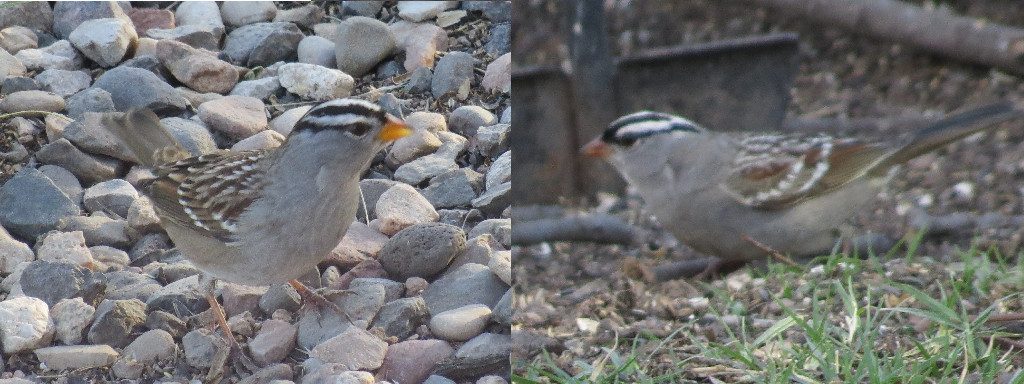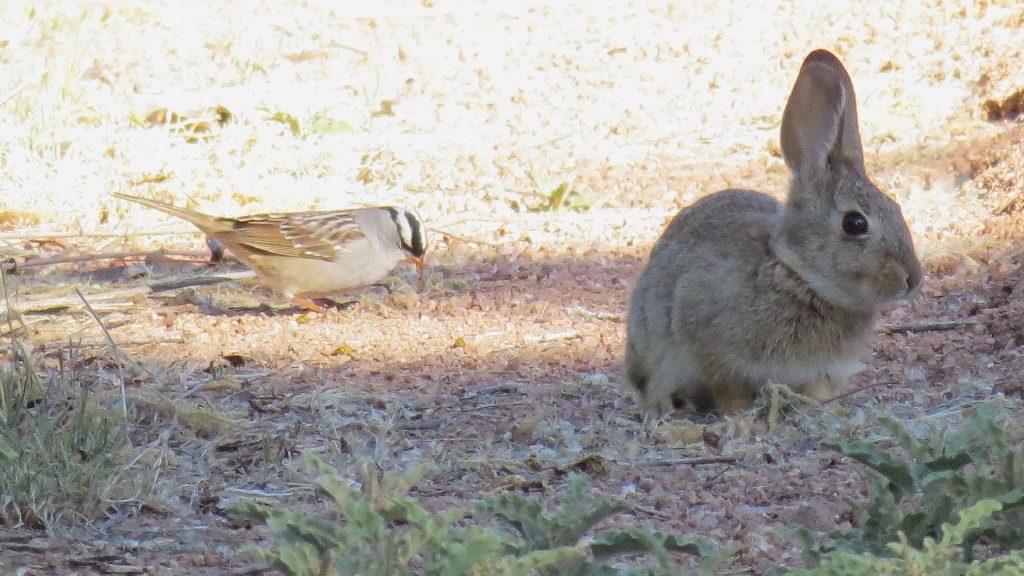Zonotrichia leucophrys
We’ve all seen White-crowned Sparrows. If you’re out birding you can’t spit without hitting one. Well, actually, they are one of the most skittish sparrows around. They can get into the bush faster than Rich Armstrong can zero-in a spotting scope. But if you have a mixed seed feeder, they’re below to pick up whatever other birds have kicked to the ground. The problem is, when you try to record them in eBird you’re given three choices: a) White-crowned Sparrow; b) White-crowned Sparrow (Dark-lored); and c) Dark-crowed Sparrow (Gambel’s). So what do you choose?

Sibley’ Birds West defines the lore as “tiny feathers between the eye and bill.” (Sibley xviii) Obviously then, a Dark-lored White-crowned Sparrow would have dark, or in the photo above right, black feathers between the eye and bill. Another less obvious difference is that the bill in the Dark-lored is more pinkish. There’s a rumor out there that these two may be split into two species one of these days, so you might as well learn to tell them apart.
Do I have to check every single one?
Luckily, no. In the Verde Valley, most of the time only one sub-species is present. Gambel’s are here from October through early May. Dark-lored migrate through in late April to early May. Gambel’s White-crowned Sparrows are thinning out by the time the Dark-lored arrive, and at that point telling them apart is not too difficult. So if it’s before May, there’s a really, really good chance it’s a Gambel’s.
First Winter White-crowned Sparrows

First winter White-crowned Sparrows look so different than adults that they are often misidentified. But if you look at the structure of the bird you will notice that the bill, legs, body shape and pattern are similar to each other. The only differences really are that the first winter bird has reddish-brown and gray stripes on the crown and has not molted into the black and white feathers of adulthood. While you might not see individual birds transforming, you might notice that you are seeing less and less birds with reddish-brown and gray stripes as winter passes.
Comparing First Winter White-crowned Sparrows to Other Species

Initially, when you see a first winter White-crowned Sparrow with its reddish-brown and gray head, the last thing you think is, “Hey. that’s a White-crowned Sparrow.” So you do what is obvious and start looking in your field guide for sparrows with reddish brown stripes. Although it is smaller, the Chipping Sparrow looks awfully similar to the first winter White-crowned (although not so similar in the above pictures). When you are seeing the birds as they flutter through dense brush, the distinction is even more difficult. The Chipping Sparrow has a smaller bill and more distinct eye-ring–giving it a greater cuteness factor. (More on the cuteness factor in an upcoming blog post.) Also, Chipping Sparrows tend to flock with other Chipping Sparrows, while first winter White-crowned Sparrows tend to flock with adults who have black-and-white striped heads.

First winter White-crowned Sparrows are also sometimes misidentified as Rufous-crowned Sparrows. However, the structure of the Rufous-crowned Sparrow is completely different from the White-crowned Sparrow and more similar to a towhee. It has a blackish bill, a black malar stripe and has a completely different posture.
Okay, So How Do I Tell a First Winter Dark-lored from a First Year Gambel’s?
The short answer is that the first winter Dark-lored has a darker lore than the Gambel’s. Luckily, you won’t likely see them together in the Verde Valley. By the time the Dark-lored White-crowned Sparrows migrate through, both sub-species will be in the adult form.
Birding Urban Legend
David Sibley took a guest birding with him in Wyoming. When they got back, the guest had a pressing question.
“What was the most interesting bird you saw today?” asked the guest.
“A White-crowned Sparrow,” replied Sibley.
“But White-crowns were everywhere,” objected the guest.
“Ah,” said Sibley, “but this one had a Colorado accent.”
The Projected impact of Climate Change on the White-crowned Sparrow
The White-crowned Sparrow, whose primary breeding grounds are from the northern U.S. to the Arctic Circle, stands to lose much of its current breeding grounds. With a 1.5 degree C global rise in temperature, it will lose 40% of its breeding area (mostly in the northern U.S.) while gaining 11% in the Arctic. (Audubon) With a 3.0 degree C temperature increase, they stand to lose 78% of their breeding grounds while gaining only 13% more grounds to the north. (Audubon)
The forecast for wintering grounds looks somewhat less bleak. With a 1.5 degree C temperature increase, White-crowned Sparrows will lose 9% of their wintering grounds (mostly in southern Arizona and Mexico) while gaining 28% more wintering grounds in the northern U.S. With a 3 degree C temperature increase, they will lose 18% of their wintering grounds (in the southern US and Mexico) while gaining 57% more wintering grounds in the northern U.S. and southern Canada. (Audubon)
The good news is that the Verde Valley might not lose any of its wintering habitat for White-crowned Sparrows. The bad news is that, with the loss of so much breeding habitat, there will probably be significantly fewer White-crowned Sparrows to winter here.
References
Audubon Guide to North American Birds White-Crowned Sparrow
Sibley, David Allen, Sibley Birds West, Field Guide to Birds of Western North America, Alfred A. Knoff, 2016
Title Photo by Chip Engelmann
